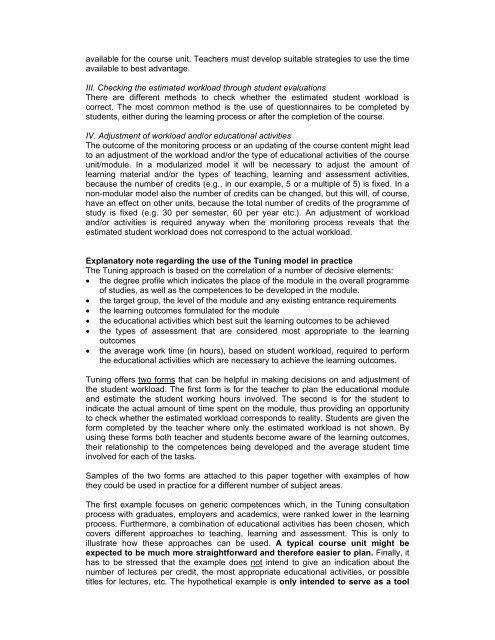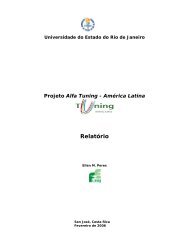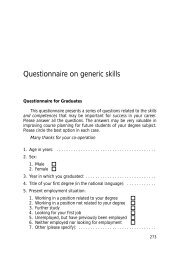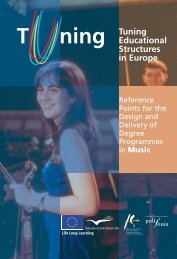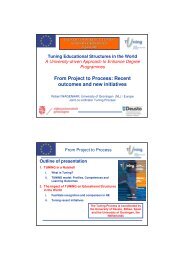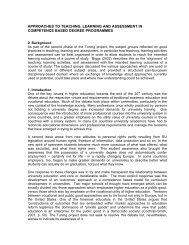student workload, teaching methods and learning ... - ECOMMIS
student workload, teaching methods and learning ... - ECOMMIS
student workload, teaching methods and learning ... - ECOMMIS
Create successful ePaper yourself
Turn your PDF publications into a flip-book with our unique Google optimized e-Paper software.
available for the course unit. Teachers must develop suitable strategies to use the timeavailable to best advantage.III. Checking the estimated <strong>workload</strong> through <strong>student</strong> evaluationsThere are different <strong>methods</strong> to check whether the estimated <strong>student</strong> <strong>workload</strong> iscorrect. The most common method is the use of questionnaires to be completed by<strong>student</strong>s, either during the <strong>learning</strong> process or after the completion of the course.IV. Adjustment of <strong>workload</strong> <strong>and</strong>/or educational activitiesThe outcome of the monitoring process or an updating of the course content might leadto an adjustment of the <strong>workload</strong> <strong>and</strong>/or the type of educational activities of the courseunit/module. In a modularized model it will be necessary to adjust the amount of<strong>learning</strong> material <strong>and</strong>/or the types of <strong>teaching</strong>, <strong>learning</strong> <strong>and</strong> assessment activities,because the number of credits (e.g., in our example, 5 or a multiple of 5) is fixed. In anon-modular model also the number of credits can be changed, but this will, of course,have an effect on other units, because the total number of credits of the programme ofstudy is fixed (e.g. 30 per semester, 60 per year etc.). An adjustment of <strong>workload</strong><strong>and</strong>/or activities is required anyway when the monitoring process reveals that theestimated <strong>student</strong> <strong>workload</strong> does not correspond to the actual <strong>workload</strong>.Explanatory note regarding the use of the Tuning model in practiceThe Tuning approach is based on the correlation of a number of decisive elements:• the degree profile which indicates the place of the module in the overall programmeof studies, as well as the competences to be developed in the module.• the target group, the level of the module <strong>and</strong> any existing entrance requirements• the <strong>learning</strong> outcomes formulated for the module• the educational activities which best suit the <strong>learning</strong> outcomes to be achieved• the types of assessment that are considered most appropriate to the <strong>learning</strong>outcomes• the average work time (in hours), based on <strong>student</strong> <strong>workload</strong>, required to performthe educational activities which are necessary to achieve the <strong>learning</strong> outcomes.Tuning offers two forms that can be helpful in making decisions on <strong>and</strong> adjustment ofthe <strong>student</strong> <strong>workload</strong>. The first form is for the teacher to plan the educational module<strong>and</strong> estimate the <strong>student</strong> working hours involved. The second is for the <strong>student</strong> toindicate the actual amount of time spent on the module, thus providing an opportunityto check whether the estimated <strong>workload</strong> corresponds to reality. Students are given theform completed by the teacher where only the estimated <strong>workload</strong> is not shown. Byusing these forms both teacher <strong>and</strong> <strong>student</strong>s become aware of the <strong>learning</strong> outcomes,their relationship to the competences being developed <strong>and</strong> the average <strong>student</strong> timeinvolved for each of the tasks.Samples of the two forms are attached to this paper together with examples of howthey could be used in practice for a different number of subject areas.The first example focuses on generic competences which, in the Tuning consultationprocess with graduates, employers <strong>and</strong> academics, were ranked lower in the <strong>learning</strong>process. Furthermore, a combination of educational activities has been chosen, whichcovers different approaches to <strong>teaching</strong>, <strong>learning</strong> <strong>and</strong> assessment. This is only toillustrate how these approaches can be used. A typical course unit might beexpected to be much more straightforward <strong>and</strong> therefore easier to plan. Finally, ithas to be stressed that the example does not intend to give an indication about thenumber of lectures per credit, the most appropriate educational activities, or possibletitles for lectures, etc. The hypothetical example is only intended to serve as a tool


